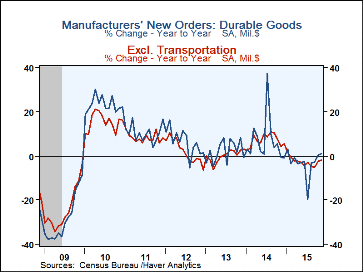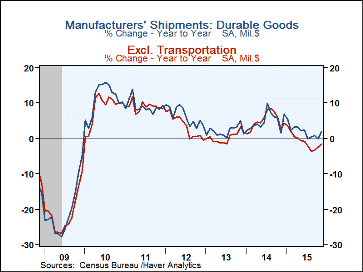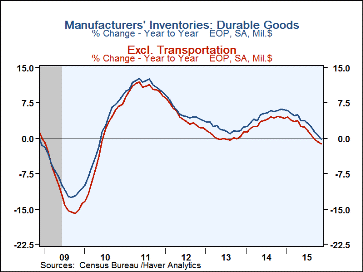 Global| Dec 23 2015
Global| Dec 23 2015U.S. Durable Goods Orders Little Changed in November
by:Sandy Batten
|in:Economy in Brief
Summary
Durable goods orders were little changed in November (+1.2%y/y) following a 2.9%m/m jump in October (revised down slightly from the initially reported 3.0%m/m rise). Action Economics' Forecast Survey had anticipated a 0.7%m/m decline. [...]
Durable goods orders were little changed in November (+1.2%y/y) following a 2.9%m/m jump in October (revised down slightly from the initially reported 3.0%m/m rise). Action Economics' Forecast Survey had anticipated a 0.7%m/m decline. A swing in orders for nondefense aircraft and parts was the major source of the November slowdown. Nondefense aircraft orders slumped 22.2%m/m in November after having surged 78.7%m/m in October. The timing of the Dubai airshow was likely behind this wide monthly swing in aircraft orders. Excluding orders in the transportation sector, other orders slipped 0.1%m/m (-1.9%y/y) after a 0.5%m/m increase in October. Market expectations looked for an unchanged reading.
Capital goods orders also moderated in November after a good start to the fourth quarter in October. Core capital goods orders (capital goods orders excluding defense and aircraft) slipped 0.4%m/m following a downwardly revised 0.6%m/m increase in October (originally +1.3%m/m). This left these orders up 1.3% AR from the third quarter average. Core capital goods shipments remained tepid in November. They fell 0.5%m/m after a downwardly revised 1.0%m/m fall in October (originally -0.5%m/m). This left these shipments down 4.8% AR from the third quarter average and augurs a weak reading for business equipment spending in the Q4 national accounts.
Across the major sectors, orders for primary metals fell 2.7%m/m, and those for machinery slumped 1.5%m/m in November. Orders for electrical equipment recovered from their October swoon, jumping up 2.6%m/m. And even with the drop in nondefense aircraft orders, transportation orders managed a 0.4%m/m increase, boosted by rises in both motor vehicles and parts, and defense aircraft.
In other parts of the report, total shipments increased 0.9%m/m (1.8%y/y) versus a 1.2%m/m decline in October. Unfilled orders added to their October gains, rising 0.2% (-2.2%y/y) in November. And inventories fell for the fifth consecutive month, declining 0.3%m/m (-0.2%y/y) in November, the same monthly decline as in October.
The durable goods figures are available in Haver's USECON database. The Action Economics consensus forecast figure is in the AS1REPNA database.
| Durable Goods NAICS Classification | Nov | Oct | Sep | Nov Y/Y | 2014 | 2013 | 2012 |
|---|---|---|---|---|---|---|---|
| New Orders (SA, %) | 0.03 | 2.88 | -0.83 | 1.20 | 6.8 | 2.2 | 6.3 |
| Transportation | 0.37 | 7.76 | -2.24 | 7.77 | 6.1 | 6.5 | 16.6 |
| Total Excluding Transportation | -0.15 | 0.50 | -0.13 | -1.93 | 7.2 | 0.1 | 2.0 |
| Nondefense Capital Goods | -6.34 | 12.07 | -5.98 | -5.59 | 6.6 | 2.8 | 10.8 |
| Excluding Aircraft | -0.41 | 0.65 | 0.47 | -1.77 | 6.3 | -1.0 | 7.6 |
| Shipments | 0.89 | -1.20 | 0.26 | 1.80 | 4.8 | 2.0 | 6.3 |
| Inventories | -0.27 | -0.32 | -0.62 | -0.19 | 6.1 | 2.4 | 3.8 |
| Unfilled Orders | 0.16 | 0.31 | -0.48 | -2.18 | 11.4 | 6.4 | 7.5 |
Sandy Batten
AuthorMore in Author Profile »Sandy Batten has more than 30 years of experience analyzing industrial economies and financial markets and a wide range of experience across the financial services sector, government, and academia. Before joining Haver Analytics, Sandy was a Vice President and Senior Economist at Citibank; Senior Credit Market Analyst at CDC Investment Management, Managing Director at Bear Stearns, and Executive Director at JPMorgan. In 2008, Sandy was named the most accurate US forecaster by the National Association for Business Economics. He is a member of the New York Forecasters Club, NABE, and the American Economic Association. Prior to his time in the financial services sector, Sandy was a Research Officer at the Federal Reserve Bank of St. Louis, Senior Staff Economist on the President’s Council of Economic Advisors, Deputy Assistant Secretary for Economic Policy at the US Treasury, and Economist at the International Monetary Fund. Sandy has taught economics at St. Louis University, Denison University, and Muskingun College. He has published numerous peer-reviewed articles in a wide range of academic publications. He has a B.A. in economics from the University of Richmond and a M.A. and Ph.D. in economics from The Ohio State University.










